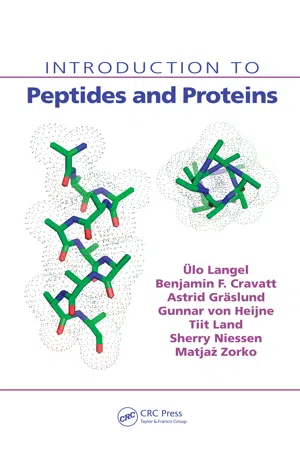
eBook - PDF
Introduction to Peptides and Proteins
This is a test
- 420 pages
- English
- PDF
- Available on iOS & Android
eBook - PDF
Introduction to Peptides and Proteins
Book details
Table of contents
Citations
About This Book
Human cells produce at least 30, 000 different proteins. Each has a specific function characterized by a unique sequence and native conformation that allows it to perform that function. While research in this post-genomic era has created a deluge of invaluable information, the field has lacked for an authoritative introductory text needed to inform
Frequently asked questions
At the moment all of our mobile-responsive ePub books are available to download via the app. Most of our PDFs are also available to download and we're working on making the final remaining ones downloadable now. Learn more here.
Both plans give you full access to the library and all of Perlego’s features. The only differences are the price and subscription period: With the annual plan you’ll save around 30% compared to 12 months on the monthly plan.
We are an online textbook subscription service, where you can get access to an entire online library for less than the price of a single book per month. With over 1 million books across 1000+ topics, we’ve got you covered! Learn more here.
Look out for the read-aloud symbol on your next book to see if you can listen to it. The read-aloud tool reads text aloud for you, highlighting the text as it is being read. You can pause it, speed it up and slow it down. Learn more here.
Yes, you can access Introduction to Peptides and Proteins by Ulo Langel, Benjamin F. Cravatt, Astrid Graslund, N.G.H. von Heijne, Matjaz Zorko, Tiit Land, Sherry Niessen in PDF and/or ePUB format, as well as other popular books in Medicine & Biochemistry in Medicine. We have over one million books available in our catalogue for you to explore.
Information
Table of contents
- Front cover
- Contents
- Preface
- Further Reading
- Biography
- From Building Blocks to 3-D Structure
- Introduction to Part I
- Chapter 1. Amino Acids
- Chapter 2. Noncovalent Interactions
- Chapter 3. Structural Organization of Proteins
- Protein Biosynthesis and Posttranslational Modifications
- Chapter 4. The Biosynthesis of Proteins
- Chapter 5. Posttranslational Modifications
- Folding of Proteins
- Chapter 6. Protein Folding
- Chapter 7. Intracellular Sorting of Proteins
- Protein Degradation
- Chapter 8. Protein Turnover
- Introduction to Part II
- Chaper 9. Purification and Characterization of Proteins
- Chapter 10. Crystallography and X-Ray Diffraction
- Chapter 11. Optical Spectroscopy
- Chapter 12. Nuclear Magnetic Resonance (NMR)
- Chapter 13. Methods to Follow Protein Folding
- Chapter 14. Mass Spectrometry
- Chapter 15. Chemical Synthesis of Peptides and Proteins
- Introduction to Part III
- Chapter 16. Protein Engineering and Gene Silencing
- Chapter 17. Protein–Ligand Interactions
- Chapter 18. Sequence Analysis and Function Prediction
- Chapter 19. Protein Structure Prediction
- Chapter 20. Proteomics
- Introduction to Part IV
- Chapter 21. Enzymes
- Chapter 22. Nucleic Acid– Binding Proteins
- Chapter 23. Cell Surface Receptors and Signaling
- Chapter 24. Membrane Proteins
- Chapter 25. Antibodies
- Chapter 26. Fibrous Proteins
- Chapter 27. Selected Classes of Bioactive Peptides
- Introduction to Part V
- Chapter 28. Misfolding-Based Diseases
- Chapter 29. Miscleavage-Based Diseases
- Chapter 30. Missequence-Based Diseases
- Chapter 31. Peptides and Proteins as Drugs
- Index
- Back cover